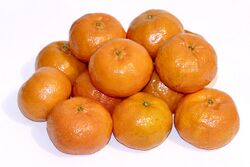Biology:Koji orange
| Koji orange | |
|---|---|

| |
| Koji orange fruits | |
| Scientific classification | |
| Kingdom: | Plantae |
| Clade: | Tracheophytes |
| Clade: | Angiosperms |
| Clade: | Eudicots |
| Clade: | Rosids |
| Order: | Sapindales |
| Family: | Rutaceae |
| Genus: | Citrus |
| Species: | C. leiocarpa
|
| Binomial name | |
| Citrus leiocarpa hort. ex Tanaka (1927)
| |
| Forms | |
| |
| Synonyms | |
| |
Koji orange (Citrus leiocarpa), also called smooth-fruited orange in English, bingyul in Korean, 光橘 (guang ju), 柑 子 (gan zi), and 日本土柑 (ri ben tu gan) in Chinese, and コウジ (kōji) in Japanese, is a Citrus species native to Japan .[1] The specific epithet (leiocarpa) comes from Greek leios (= smooth) and karpon (= fruit). It is a taxonomical synonym of Citrus aurantium.[2]
Distribution
Besides Japan , it is grown in the United States , and other parts of East Asia including South Korea and China .[2]
Description
The fruit is oblate in shape, slightly ribbed, bright orange in color, very small, and very seedy, and for the latter two reasons it is not grown for commercial use. It ripens from October through November and has been cultivated since at least 1900. It may be monoembryonic. The tree is densely branched and has a broad crown and a short, straight trunk. The leaves are dark green and elliptical in shape.[1]
Genetics
Citrus leiocarpa is inferred to be a hybrid between a koji-type species (seed parent) and the tachibana orange (pollen parent, Citrus tachibana). Its genotype matches with that of the komikan and toukan varieties.[3]
Varieties
Citrus leiocarpa f. monoembryota, a form of Citrus leiocarpa, was described by Chozaburo Tanaka. Once believed to be a mutation of the koji orange, it has been revealed that it is a hybrid between koji (pollen parent) and kishu (seed parent).[3] In Chinese, it is called 駿河柑子 (jun he gan zi) and is called スルガユコウ (suruga yukō) and 駿河柚柑 (suruga yuzukan) in Japanese.[4]
See also
References
- ↑ Jump up to: 1.0 1.1 "CRC3147". https://citrusvariety.ucr.edu/citrus/CRC3147.html.
- ↑ Jump up to: 2.0 2.1 "Citrus leiocarpa hort. ex Tanaka" (in en). https://www.gbif.org/species/3831621.
- ↑ Jump up to: 3.0 3.1 Shimizu, Tokurou; Kitajima, Akira; Nonaka, Keisuke; Yoshioka, Terutaka; Ohta, Satoshi; Goto, Shingo; Toyoda, Atsushi; Fujiyama, Asao et al. (30 November 2016). "Hybrid Origins of Citrus Varieties Inferred from DNA Marker Analysis of Nuclear and Organelle Genomes". PLOS ONE 11 (11): e0166969. doi:10.1371/journal.pone.0166969. PMID 27902727. Bibcode: 2016PLoSO..1166969S.
- ↑ "M.M.P.N.D. - Sorting Citrus names part1". http://www.plantnames.unimelb.edu.au/Sorting/Citrus_1.html.
Wikidata ☰ Q10349285 entry
 |

